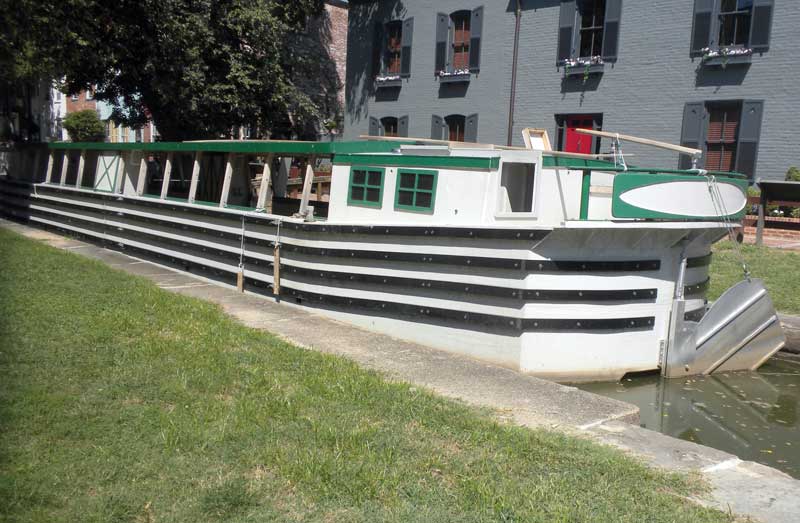Have you ever taken a cruise along an historic local canal? I did. There’s a canalboat cruise between Locks 3 and 4 of the Chesapeake & Ohio Canal in Georgetown (adjacent to downtown Washington, DC) that runs several days a week in season (the 2022 tour season has concluded).

The C&O Canal cruise takes about an hour. On a recent Saturday, I joined a full ship of tourists, seated two to a bench. Although canalboats are simplistic, there is a head aboard. Everyone enjoyed the personable and historically knowledgeable young woman who delivered a witty performance as she narrated our cruise.
Before the C&O Canal was built, various efforts were undertaken to improve transportation along the Potomac, since it was the only river on the East Coast that bisected the Appalachians. That’s why the Potomac was the preferred route for western trade.
During his career as a land surveyor, George Washington was among the first to champion the idea of building a canal that would make the Potomac more navigable. Once he threw his energy into winning the Revolutionary War, followed by running our young country as the first U.S. President, he obviously had bigger issues to address. Although he never gave up on the idea, no real progress had been made when he died in 1799.
The canal’s construction kicked off with a groundbreaking ceremony on July 4, 1828, attended by our sixth U.S. President, John Quincy Adams. Sawmills sprouted along the route to support the canal’s construction effort.
Clearly it was an arduous task during those 22 back-breaking years of construction. The canal was mostly hand-dug by Irish immigrants, some Germans, and African Americans. “The workers job was to dig a canal six feet deep and 60 feet wide at the assumed water surface, and 48 feet wide at the canal bottom.”
These laborers lived under difficult conditions (often with their wives and children) alongside the canal as the digging progressed. Fights were common, usually based on ethnic heritage or work effort.
Once the canal was finished in 1850, the 184.5-mile trip from Cumberland, MD (at the base of the Appalachian Mountains), to Georgetown in Washington, DC, typically took seven days. Communities in western Maryland sprouted up along the waterway as trade increased and flour, grain, building stone, and whiskey began to move down to Georgetown.

Once the canal reached Cumberland, the tonnage being transported increased substantially. Large quantities of coal were shipped, and by 1871 (the canal’s peak year) over 850,000 tons were carried down the canal. Trade was so brisk that at times over 500 boats were operating on the C&O Canal.
Using buckets, some coal was unloaded directly into the Georgetown coal yards. Coal was also unloaded onto four-masted ocean sailing vessels bound for Massachusetts (which brought ice and returned with coal).
Other cargo transported along the canal included everything from pre-owned furniture and pianos to fish (like herring) and watermelons. Provisions were also delivered to lockkeepers.
Some “poled” across the Potomac River at Dam No. 2 to get wood, crossties, bark (used in tanning), and grain. Other loads, often carried upstream, included 600 empty barrels in a boat that was used to transport cement, lumber, fertilizer, and general merchandise for stores along the canal.
Cement from the Round Top Mill near the Maryland-Pennsylvania border was shipped to Georgetown. In fact, the Mill also shipped cement to the Washington Monument and the U.S. Capitol.
In 1889 everything changed. After a disastrous flood, the canal’s management entered receivership with court-appointed trustees. The trustees—who represented the majority owners of the C&O Canal Company bonds issued back in1844—were given the right to repair and operate the canal under continued court oversight.
The Baltimore & Ohio (B&O) Railroad tussled in court with the C&O Canal as early as 1828, when both companies were competing to buy land along the Potomac. Although the B&O owned the majority of the 1878 bonds, it did not own a majority of the 1844 bonds in the immediate aftermath of the flood. But by 1903, the B&O acquired sufficient bonds to become “a majority holder.”
In 1938, the U.S. Government purchased the C&O, which is managed by the Dept. of the Interior. Today, it’s a U.S. National Historic Park.
By Chris “Seabuddy” Brown